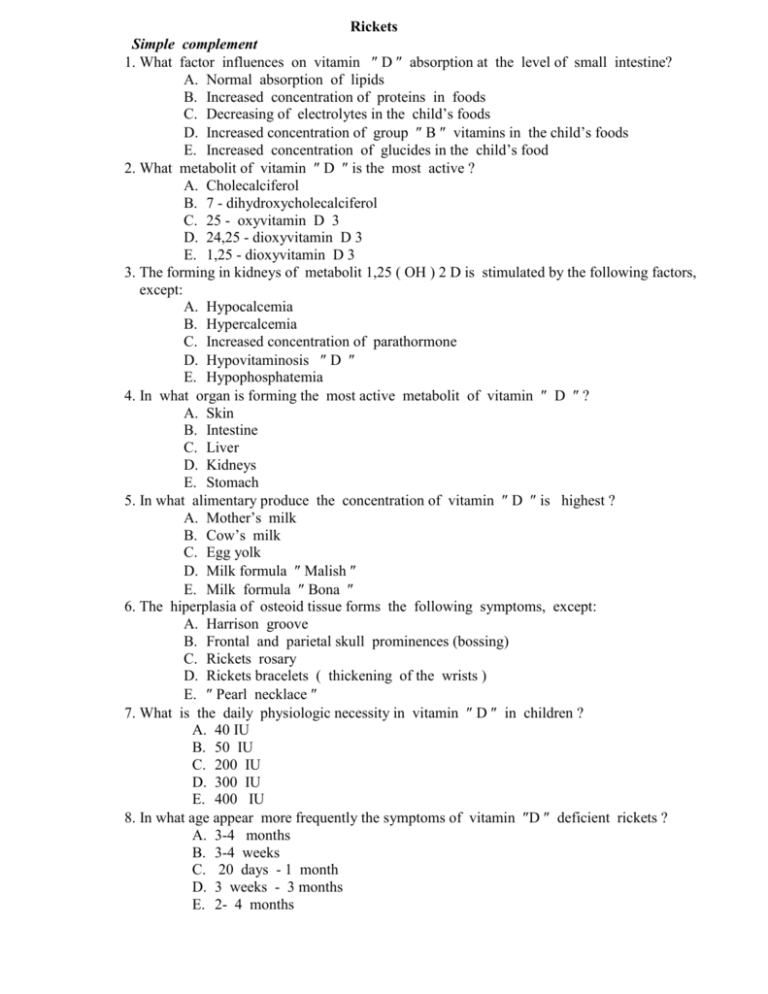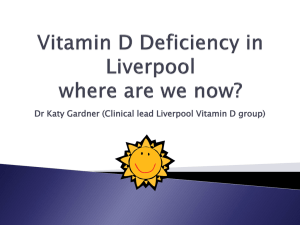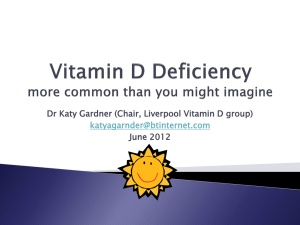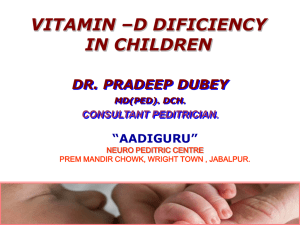The rickets
advertisement

Rickets Simple complement 1. What factor influences on vitamin D absorption at the level of small intestine? A. Normal absorption of lipids B. Increased concentration of proteins in foods C. Decreasing of electrolytes in the child’s foods D. Increased concentration of group B vitamins in the child’s foods E. Increased concentration of glucides in the child’s food 2. What metabolit of vitamin D is the most active ? A. Cholecalciferol B. 7 - dihydroxycholecalciferol C. 25 - oxyvitamin D 3 D. 24,25 - dioxyvitamin D 3 E. 1,25 - dioxyvitamin D 3 3. The forming in kidneys of metabolit 1,25 ( OH ) 2 D is stimulated by the following factors, except: A. Hypocalcemia B. Hypercalcemia C. Increased concentration of parathormone D. Hypovitaminosis D E. Hypophosphatemia 4. In what organ is forming the most active metabolit of vitamin D ? A. Skin B. Intestine C. Liver D. Kidneys E. Stomach 5. In what alimentary produce the concentration of vitamin D is highest ? A. Mother’s milk B. Cow’s milk C. Egg yolk D. Milk formula Malish E. Milk formula Bona 6. The hiperplasia of osteoid tissue forms the following symptoms, except: A. Harrison groove B. Frontal and parietal skull prominences (bossing) C. Rickets rosary D. Rickets bracelets ( thickening of the wrists ) E. Pearl necklace 7. What is the daily physiologic necessity in vitamin D in children ? A. 40 IU B. 50 IU C. 200 IU D. 300 IU E. 400 IU 8. In what age appear more frequently the symptoms of vitamin D deficient rickets ? A. 3-4 months B. 3-4 weeks C. 20 days - 1 month D. 3 weeks - 3 months E. 2- 4 months 9. The vitamin D deficient rickets by III degree is characterising by the following symptoms , except : A. Prononced bone deformations B. Severe anemia C. Severe affection of internal organs D. Neuromotor and physical retardation E. Normal biochemical indices in the blood 10. The signs of vitamin D deficient rickets onset are the follows, except : A. Craniotabes B. Increased sweating C. Occipital alopecia D. Troubled sleeping E. Red, stable dermographism 11. The following deformations of thorax can be observed in vitamin D deficient rickets, except : A. Anterioposterior plate chest B. Bottomed sternum ( shoemaker sternum ) C. Pigeon chest D. Harrison groove E. Bulging of thorax in the region of heart 12. The signs of osteomalacia in deficient rickets are the follows, except: A. Craniotabes B. Increased flexibility of anterior fontanelle margins C. Harrison groove D. Flattened occipital region E. Occipital alopecia 13. The differential diagnosis of rickets is performing with the following diseases, except: A. Phosphaturic renal diabetes B. Tubular renal acidosis, type I C. Acute pneumonia D. De Toni - Debre - Fanconi syndrome E. Vitamin D dependent rickets 14. What factor does not influence on deficient rickets appearance in premature babies ? A. The absence of exposition at sun light long time after birth B. Defected absorption of liposoluble vitamins C. Insufficient development of respiratory sistem D. More intensive growing of premature babies E. Insufficient antenatal storage of calcium and phosphorus 15. The pathogenetic mechanisms of rickets are the follows, except: A. Decreased intestinal absorption of calcium B. Decreased reabsorption of phosphorus at the level of tubular system C. Increased secretion of parathormone D. Decreased reabsorption of glucose at the level of tubular system E. Deficit of bone matrix ossification Multiple complement : 1. The deficient rickets is characterized by the following periods : A. Period of onset B. Period of state C. Period of reconvalescence D. Period of postrachitic sequelae E. Advanced period 2. What are the vitamin D preparations ? A. Calciferol B. Oxydevit C. Calcidiol D. Calcitriol E. Bio- splat 3. The classification of deficient rickets, proposed by S.O.Dulitzkii, includes : A. Period of disease B. Degree of disease severity C. Evolution of disease D. Etiologic factor E. Character of cardiovascular system affection 4. The period of deficient rickets state is during with the folloving skull affection signs: A. Craniotabes B. Absence of occipital part flattening C. The head in the form of box D. Olympic forehead E. Frontal and parietal proeminences ( bossing ) 5. The functions of metabolit 1,25 ( OH ) 2 D 3 are : A. Not influences the intestinal absorption of calcium B. Influences the bones mineralization C. Influences the synthesis of osteocalcine D. Increases the reabsorption of calcium and phosphorus in renal tubules E. Influences the muscular contractibility 6. On what organs influences the metabolit 1,25 - dihydrocholecalciferol ? A. Small intestine B. Kidneys C. Lungs D. Muscular system E. Paratyroid glands 7. The synthesis of 25 ( OH ) D 3 in liver in activated by : A. Hypocalcemia B. Hypovitaminosis ,, D’’ C. Hyperparathyroidism D. Hypercalcemia E. Hypovitaminosis ,, A’’ 8. What is the role of parathormone in the pathogenesis of deficient rickets ? A. Mobilizes the calcium from bones in conditions of hypercalcemia B. Stimulates the synthesis of 1,25 (OH )2 D3 C. Stimulates the reabsorption of calcium and magnesium in renal tubules D. Increases the excretion of phosphates with urine E. Increases the excretion of bicarbonates with urine 9.The muscular hypotonia observed in deficient rickets occurs with the following signs : A. The thorax in the form of bell B. The ,, frog’’ abdomen C. The breaking up of right abdomenal muscle D. Dorsolombar kyphosis E. Harrison groove 10. The nonspecific antenatal prophylaxis of rickets includes : A. Unreasonable using of maternity leave B. Respecting of well thought -out regime C. Walking on fresh air D. Alimentation of pregnant woman conformable to physiologic necessities E. Evidence of pregnant women with increased risk of precocious rickets appearance in babies after birth 11. The evolution of deficient rickets can be : A. Acute B. Subacute C. Recurrent D. Latent E. Progressive 12. What processes have place at the level of long bones during the period of organism’s growing ? A. The process of ossification B. The accumulation of vitamin D in bone tissue C. The process of bone reabsorption, connected specifically by skeletal calcium mobilization for constant maintaining of calcemia D. The process of bone modelling E. Hyperplasia of osteoid tissue 13. In what organs takes place the metabolization of vitamin ,, D’’ ? A. Skin B. Kidneys C. Liver D. Lungs E. Intestine 14. What dental disorders are observed in the case of acquired deficitar rickets? A. Delayed eruption of temporary teeth B. Hypoplasia of enamel C. Predisposing to caries of permanent teeth D. Precocious eruption of permanent teeth E. Precocious eruption of temporary teeth 15. The following data are used for deficient rickets diagnosis : A. Clinical examination B. Biochemical changes in blood C. Radiologic data with characteristic changes D. Indices of physical development E. Functional state of cardiovascular system 16. What are the physiologic effects of 1,25 ( OH )2 D3 at the level of muscles ? A. Maintaining of normal muscular tonus B. Ensuring of normal contractibility force C. Influences the increasing of ATP quantity in muscles D. Increases the muscular proteins synthesis E. Decreases the muscular proteins synthesis 17. What factors decrease the efficacity of solar rays ? A. Nordic Latitude B. Usual glass C. Increased concentration of dust in air D. The spring season E. Skin pigmentation 18. What are the physiologic effects of 1,25 (OH)2 D3 at the level of bones ? A. Increases the bone mineralization B. The role of control on bone calcium and phosphorus mibilization process, realized by parathormone C. Influences the skeleton growing D. Stops the process of ossification E. Stimulates the osteoid tissue hyperplasia 19. The following degrees of severity are distinguished in the deficient rickets : A. Degree 0 B. Degree I C. Degree II D. Degree III E. Degree IV 20. What changes on the level of long bones are characteristic for deficient rickets ? A. Rickets ,, bracelets’’ B. Coxa vara C. Genu varum D. Deformations in the form of ,,0’’ or ,,X’’ E. Harrison groove 21. The positive diagnosis of deficient rickets is based on : A. Clinical picture B. Normal or decreased serum calcium C. Hyperphosphatemia D. Increased level of parathormone in blood E. Decreased level of vitamin D metabolits ( 25 (OH)D3; 1,25 (OH)2 D3) 22. What factors influence the lesions of bones in deficient rickets ? A. Decreased resistance of bone to mechanical loading B. Insufficient mineralization of bone organic matrix C. Hyperplasia of cartilaginous cells D. Deformation of bones E. Increased concentration of calcium in bones 23. The acute evolution of deficient rickets is characterized by : A. More frequently appearance in premature babies B. It has place in winter-spring period C. Marked general manifestations D. Predomination of osteomalacia in the bone affection E. It is frequently observed in adults 24. The subacute evolution of deficient rickets is characterized by: A. Moderate expression of rickets general signs B. Predomination of osteoid tissue hyperplasia symptoms C. Moderate prononced signs of osteomalacia D. Alkaline phosphatase is not increased E. Frontal and parietal bosses are bulged 25. What are the peculiarities of bone system affection in rickets ? A. The affections of skull bones predomine in the first 3 months of baby ‘s life B. The affection of thorax is more prononced from 2 until 6 months C. The long bones are affected after the age of 6 months D. The deformation of legs has place after the age of 3 months E. The legs in the form of ,,0’’ or ,,X’’ are more prononced in the age of 1 year .







